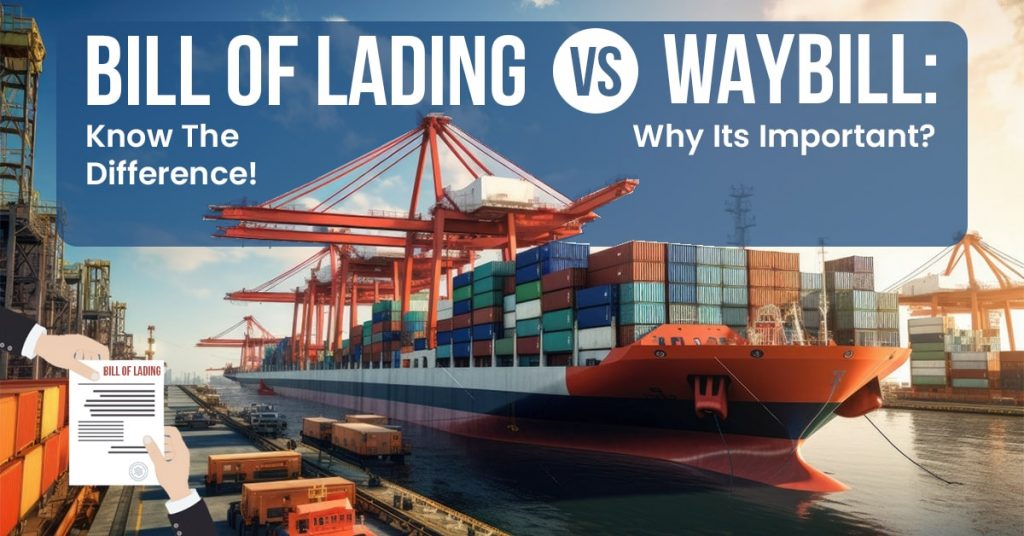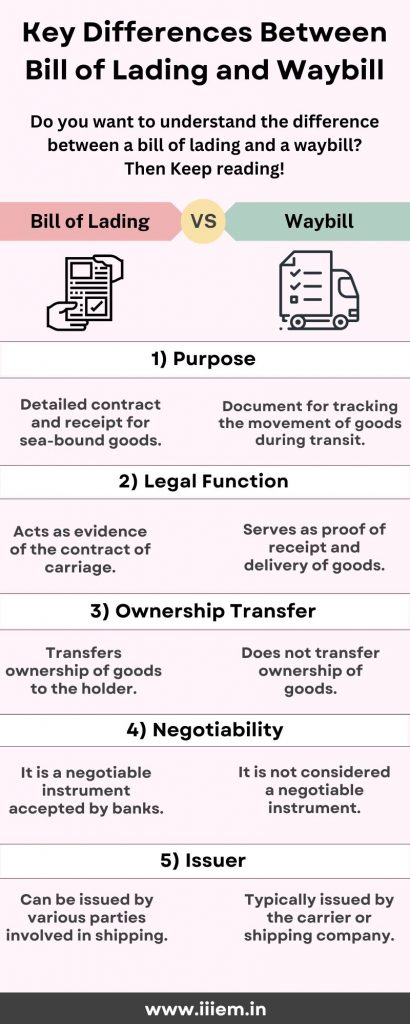
Do you want to understand the difference between a bill of lading and a waybill? Keep reading!
When you ship goods by sea, you deal with lots of paperwork. But the two main documents you need to know about are the bill of lading and the waybill. People often mix them up, but they each have specific jobs when you’re sending stuff overseas. However, they’re still connected! The key difference between them is where and why they’re used.
So, what’s the deal? Well, the bill of lading acts like a receipt for your exported goods and a contract for transportation. On the flip side, a waybill is proof that the bill of lading is real and serves as a contract.
Let’s break it down further to see how they’re different and what each one does.
Key Differences Between Bill Of Lading And Waybill
1. Bill of Lading
When goods are transported by sea, a document called the Bill of Lading (B/L) is crucial. It’s required by the U.N. Commission on International Trade Law and serves as important information, a receipt, and a contract for the transaction. Various parties involved in shipping can issue the B/L, including carriers, transport agents, shipping companies, vessel operators, or even the ship’s captain.
The B/L plays several vital roles. Firstly, it acts as a receipt for the goods being transported and confirms their apparent condition. It also serves as evidence of the carriage contract and a document of title, transferring ownership of the goods to the holder, who can then collect them from the carrier at the destination port.
Moreover, the B/L is recognized as a negotiable instrument and is accepted by banking institutions. It includes the names of the shipper, the carrier, the exporter, the consignee, and the notify.
A Bill of lading must contain the following information to be considered valid:
– The accurate name and address of the shipper
– The accurate name and address of the carrier
– The name and nationality of the vessel
– Unloading and loading final destinations
– The accurate name and address of the receiving entity or person of your goods
– The quantity, weight, and any identifying marks of the packages, if applicable.
– INCOTERMS
– The number of original copies submitted
– The date, location, and signature of either the carrier, shipping company, vessel operator, or captain
2. Waybill
A Waybill is a document used in shipping to monitor the movement of goods during transportation. It contains important details about the shipment, including where it’s from, where it’s going, and the path it will take, as well as information about the sender (consignor) and recipient (consignee).
This document is employed by the carrier, like a shipping company or a trucking firm, to record the journey of the goods and to monitor their advancement. Typically, a Waybill includes:
– Contact information of the sender (consignor) and receiver (consignee).
– Description of the goods, including type, quantity, and weight.
– Origin and destination of the shipment, along with the planned route.
– Pickup and delivery dates and times.
– Special instructions like temperature controls, handling specifics, or customs needs.
– It’s important to understand that the Waybill doesn’t transfer ownership of the goods or act as a receipt. Instead, it’s a tool to track the goods’ movement and ensure they reach their destination on time.
– The Waybill can be in electronic or paper format and is usually prepared by the carrier. It works alongside other shipping documents such as the Bill of Lading or Delivery Order to facilitate smooth transportation.
Difference Between Waybill And Bill Of Lading: Are Both Essential?

Whether both documents are needed depends on the shipment details. Generally, a Bill of Lading (B/L) holds the utmost importance for shipping goods by sea. It lays out transportation terms and conditions, describing the goods, their weight, volume, and destination. Additionally, it confirms receipt of the goods in good condition and acts as proof of ownership.
Conversely, a Waybill is utilized to monitor goods’ movement and track their progress during transportation. While not as comprehensive as the B/L, the Waybill still ensures accurate delivery timing and location.
In certain cases, both the B/L and Waybill may be necessary. For instance, the B/L might be vital for legal and financial purposes, while the Waybill aids in tracking and coordination. Ultimately, the need for both documents hinges on the shipment’s specific requirements and the involved parties in the transport process.
Understanding the difference between a Bill of Lading and a Waybill is essential for efficient shipping operations, especially in the realm of import-export business. The Bill of Lading serves as a comprehensive contract and receipt for sea-bound goods, while the Waybill is crucial for monitoring their journey. Both documents are pivotal in ensuring timely and secure deliveries. For those engaged in importing and exporting, grasping the significance of these documents is paramount. With the right knowledge, obtained perhaps through an esteemed institution like iiiEM – Export Import Course in India, businesses can streamline operations and avoid potential hurdles, ensuring successful shipments every time.
